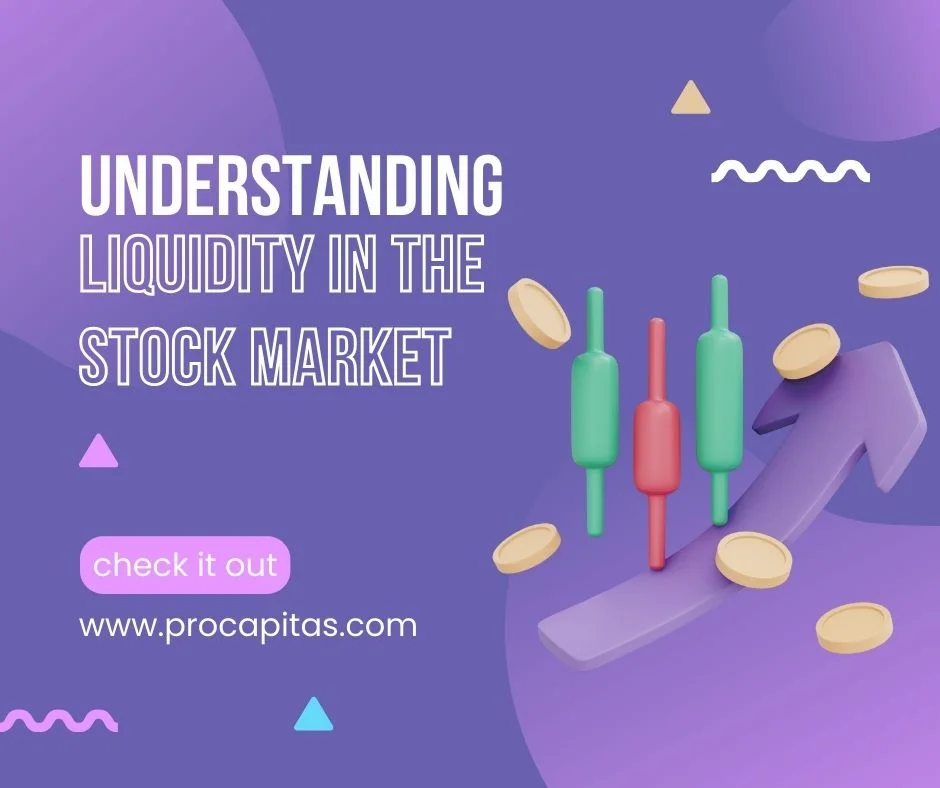Liquidity in the stock market is essential for the smooth operation of financial markets, serving as the lifeblood that enables investors to trade assets like stocks swiftly and efficiently.
It's all about how easy it is to buy or sell something without messing up the prices too much. Think of it as the ability to turn your stuff into cash quickly without losing a lot of value in the process.
This liquidity ensures that investors can move in and out of positions with minimal fuss, without causing big swings in prices.
Picture a busy marketplace where people are constantly buying and selling goods without causing chaos—that's what liquidity does in the stock market. It ensures that there's always someone willing to buy or sell stocks, making it easier for everyone to participate in the market.
Whether you're a big institution making million-dollar trades or a regular person buying a few shares, liquidity ensures that you can do it smoothly. When markets are liquid, prices tend to be fairer because there's a lot of trading activity, so nobody can easily manipulate prices.
Plus, liquidity helps reduce risk. If you need to get out of an investment quickly—maybe because things are getting shaky—liquidity ensures you can sell your stocks without much trouble.
In short, liquidity is like the oil that keeps the market engine running smoothly, ensuring that buying and selling stocks is easy, fair, and safe for everyone involved.
An in-depth overview of stock market liquidity and how it works.
1. Bid-Ask Spread:
The bid-ask spread plays a crucial role in assessing liquidity within the stock market. This spread refers to the disparity between the highest price a buyer is willing to pay (the bid) and the lowest price a seller is willing to accept (the ask). When the bid-ask spread is narrow, it signals a higher level of liquidity in the market. Essentially, a narrow spread indicates that there are numerous buyers and sellers actively engaging in transactions for the asset.
This abundance of market participants facilitates smoother trading processes, as there is a greater likelihood of finding a suitable counterparty to complete a trade at a price close to the current market value.
In contrast, a wider bid-ask spread suggests lower liquidity, as there may be fewer active traders or a mismatch in the supply and demand for the asset. Consequently, wider spreads can lead to increased transaction costs and potentially slower trade execution, as buyers and sellers may struggle to find mutually agreeable terms. Overall, monitoring the bid-ask spread provides valuable insights into the liquidity dynamics of the stock market, helping investors gauge the ease of buying and selling assets while minimizing price impact.
2. Volume:
Volume plays a significant role in determining liquidity in the stock market. It acts as a barometer of market activity, measuring the total number of shares or contracts traded within a specified timeframe.
When trading volume is high, it indicates robust participation from market participants, with a flurry of buying and selling activity.
In such instances, liquidity tends to be higher, as more buyers and sellers are interacting in the market. Think of it like a bustling marketplace where there's a constant stream of people buying and selling goods.
This high level of activity ensures that there are plenty of opportunities for investors to execute trades without significantly impacting prices. On the other hand, low trading volume suggests less active participation in the market, which can lead to lower liquidity.
In a quiet market, it may be more challenging to find counterparties to trade with, potentially resulting in wider bid-ask spreads and increased price volatility.
Therefore, monitoring trading volume is essential for assessing liquidity conditions in the stock market, as it provides valuable insights into the level of market activity and the ease of executing trades.
3. Market Depth:
Market depth, a crucial aspect of liquidity in the stock market, delves into the intricate layers of trading dynamics beyond the surface bid and ask prices.
Essentially, it measures the abundance of buyers and sellers lurking at different price levels, offering a panoramic view of the market's liquidity landscape. In a market with high liquidity and deep order books, you'll find a bustling ecosystem teeming with participants eager to buy and sell securities at various price points.
This abundance of trading interest not only facilitates smoother transactions but also ensures ample opportunities for investors to enter or exit positions without causing substantial price shifts.
It's akin to exploring the depths of a vast ocean, where myriad creatures coexist in harmony, each contributing to the ecosystem's richness and resilience. Similarly, in a liquid market with robust market depth, the presence of numerous buyers and sellers across different price levels fosters a vibrant trading environment characterized by efficiency and stability.
This depth of liquidity not only enhances market transparency but also instills confidence among investors, as they navigate the market with greater ease and assurance, knowing that their orders can be executed promptly and without undue price impact.
In essence, market depth serves as a vital barometer of liquidity, illuminating the underlying dynamics that drive the smooth functioning of financial markets and underpin the resilience of the trading ecosystem.
4. Market Impact:
The impact of liquidity on the market extends beyond facilitating smooth trading; it also plays a crucial role in how large trades affect prices.
In markets with low liquidity, commonly called illiquid markets, sizable buy or sell orders can substantially impact prices.
These large trades may lead to a phenomenon known as slippage, where the executed price differs significantly from the expected price, resulting in unfavourable outcomes for the trader.
This is because there aren't enough buyers or sellers to absorb such large transactions without causing significant price movements. On the other hand, in liquid markets, characterized by ample trading activity and depth, large trades can be absorbed more easily without causing substantial price changes.
This means that even significant buy or sell orders are less likely to disrupt the market equilibrium, resulting in minimal slippage and more favourable execution prices for traders.
In essence, liquidity acts as a buffer against market volatility, ensuring that even large trades can be executed efficiently without causing undue disruption to market prices.
5. Market Makers and Liquidity Providers:
Market makers are the unsung heroes of financial markets, playing a pivotal role in ensuring liquidity and efficiency.
These entities, whether they be specialized firms or individual traders, are the backbone of market activity, continuously quoting bid and ask prices for various securities. Their readiness to buy and sell at these quoted prices provides a vital service to investors by facilitating smooth and seamless trading.
Without market makers, the process of buying and selling securities would be far more cumbersome, with investors struggling to find counterparties for their trades.
Moreover, market makers help to narrow bid-ask spreads, which is the difference between the highest price a buyer is willing to pay and the lowest price a seller is willing to accept.
By narrowing these spreads, market makers contribute to lower transaction costs for investors and foster a more liquid market environment.
In essence, market makers act as the linchpin that keeps the wheels of financial markets turning, ensuring that liquidity flows freely and transactions can be executed efficiently.
6. Impact of News and Events:
Liquidity in the stock market is a dynamic concept, subject to fluctuations influenced by various factors such as market conditions, news events, and broader economic trends.
In times of uncertainty or heightened volatility, liquidity levels can experience significant shifts.
When investors perceive increased risk in the market, they tend to become more cautious, resulting in a decrease in trading activity.
This cautiousness can lead to a drying up of liquidity as investors hesitate to buy or sell assets. As a consequence, bid-ask spreads may widen, reflecting the increased reluctance of market participants to transact at previous price levels.
Moreover, lower trading volumes during such periods further exacerbate liquidity challenges, as there are fewer active buyers and sellers in the market.
The combination of wider spreads and diminished trading activity can make it more difficult for investors to execute trades at desired prices, impacting the efficiency and functioning of the market.
Therefore, understanding the dynamic nature of liquidity and its susceptibility to external factors is crucial for investors navigating the complexities of the stock market.
7. Regulatory Factors:
Regulatory measures wield significant influence over liquidity dynamics in the stock market, serving as both guardrails and constraints on market activity.
Take, for instance, the Volcker Rule, a cornerstone of post-financial crisis regulatory reforms aimed at curbing excessive risk-taking by banks.
This rule restricts proprietary trading by banks, limiting their ability to engage in certain speculative activities. While intended to enhance financial stability, such regulations can inadvertently affect market liquidity by reducing the participation of major market players, such as banks, in trading activities. Similarly, restrictions on short selling, imposed to prevent market manipulation or excessive speculation, can also impact liquidity.
Short-selling restrictions limit the ability of investors to bet on the decline of a stock's price, potentially reducing trading activity and liquidity in those securities.
While these regulations aim to safeguard market integrity and investor confidence, they can introduce friction into the market ecosystem, altering the balance between liquidity provision and risk management.
Therefore, understanding the interplay between regulatory measures and liquidity dynamics is essential for market participants and regulators alike, as they seek to strike a delicate balance between maintaining market stability and fostering vibrant trading environments.
FAQ:
Is liquidity the same for all stocks?
No, liquidity can vary significantly among different stocks based on factors such as market capitalization, trading volume, and investor interest. Generally, large-cap stocks with high trading volumes tend to have higher liquidity compared to small-cap stocks with lower trading volumes.
How can investors manage liquidity risk in their portfolios?
Investors can manage liquidity risk by diversifying their portfolios across different asset classes and investment strategies. They can also use limit orders to specify the price at which they are willing to buy or sell a stock, which can help mitigate the impact of wider bid-ask spreads.
Are there different types of liquidity in the stock market?
Yes, liquidity can be categorized into two types: market liquidity and funding liquidity. Market liquidity refers to the ease of buying and selling assets in the market while funding liquidity relates to the availability of cash or credit to investors for purchasing assets.
How does liquidity impact stock prices?
Generally, stocks with higher liquidity tend to have narrower bid-ask spreads and are less volatile. Increased liquidity can lead to more efficient pricing as it reflects a higher level of market activity and participation. Conversely, stocks with lower liquidity may experience wider bid-ask spreads and higher volatility, making them riskier to trade.
Why is liquidity important for investors?
Liquidity is crucial for investors because it ensures that they can enter and exit positions in the market without causing substantial changes in the asset's price. High liquidity typically means lower transaction costs and less risk of price manipulation.
Conclusion:
liquidity stands as a cornerstone for the effective operation of financial markets, offering investors the invaluable capacity to buy and sell assets at equitable prices swiftly. This critical aspect of market function is shaped by a multitude of factors, including bid-ask spreads, trading volume, market depth, the participation of market makers, and the regulatory framework in place. A robust level of liquidity fosters price efficiency and mitigates transaction costs, thereby enhancing market accessibility and fostering fairer trading environments. Ultimately, high liquidity benefits individual investors and bolsters the resilience and vibrancy of the broader market ecosystem.











 1,499
1,499
